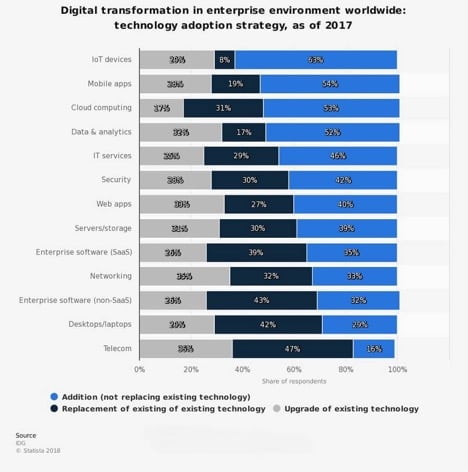Digitalisation is a multifaceted process and the very specifics depend on your industry and actual business operations. One thing that is common across the digitalisation process is that you always have interface where you either utilise data, take actions based on data or enter some data. Therefore, a mobile device is the natural end-point of digitalisation independently of the underlying technology or device manufacturer.
Digitalisation Plans Are Not Only about Costs
Innovative managers in today’s enterprises who intend to improve the overall business performance, achieve efficiency gains and introduce a more favorable work environment are usually making the mistake of drafting their use cases in silos.
What this means is they plan only for the purchasing costs of a device, development of a solution as well as for the cost of the ensuing training and maintenance.
A feasible method for calculating the costs of digitalisation is to analyse more than one use case and plan for multiple business use scenarios. The more business use cases you have at hand, the more valuable plan for digital transformation you have for transition toward working enterprise mobility solution.
A thorough use case for implementing an enterprise mobility strategy should cover aspects such as collaboration, workflows, and use of news/data collecting apps. You have to calculate the costs for a period of 2-3 years or more, including the costs pertaining to support and maintain your elected device/s. The selection of a mobile device/s to incorporate into your enterprise mobility strategy is of utmost importance as there are costs for updating and maintaining the respective hardware and software, as well as costs related to keep your mobile networking secure.
Network Security Is a Main Challenge
Budgeting for mobile digitisation apart, we can point at cyber security as the single most challenging task before an enterprise that is going all in into digitalising their business operations and workflows. As you can see in the chart below, most adoptions of new technology by businesses worldwide pertain to introduction of IoT devices, use of mobile apps and shift to cloud computing solutions.
Technologies Involved in Enterprise Digitalisation Worldwide
 Source:Statista
Source:Statista
All these technologies represent a pain in the butt in terms of security challenges they pose for enterprises. The Internet of Things (IoT) produces the most pressing security challenges as the majority of the existing hardware one can use to build an IoT network come with built-in holes in security either in terms of unsecure firmware or use of unsecure communication protocols.
The widespread adoption of mobile apps and cloud platforms as building blocks of enterprise mobility digitalisation is another security challenge you cannot take lightly. The use of mobile apps and cloud services means that your employees will often use a service outside your network perimeter and might connect to these apps and services using unsecure Wi-Fi hotspots. Implementing a corporate VPN can reduce the security risks but cannot eliminate them as the very third-party solutions should also be secure.
You should therefore always plan for security solutions such as VPNs, firewalls, etc. when drafting your overall enterprise mobility strategy while having a good idea how secure is the platform or app you plan to use.
Actually, a business could adopt the most secure hardware i.e. mobile device on the planet but it does not work in isolation. It connects to other networks and devices, so secure both your corporate network and the methods for connecting to external networks.
Have a Thorough BYOD Policy in Place
You may ban the use of personal devices in the office but your employees will still access websites related to their work through their personal smartphones, tablets and laptops. They will open emails on these devices and some people will even login to corporate resources available online using an unsecure mobile device.
On the other hand, many companies are eager to adopt a bring-your-own-device approach, enabling their employees to use any mobile device they deem appropriate. Or almost any.
The use of personal mobile devices offers many advantages for businesses but there are specific challenges to overcome. First, you need to have a strict mobile device management (MDM) policy in place. Even a single compromised device can result in your entire corporate network being penetrated by a malicious third-party agent. If you develop or use mobile apps to run your business, you need also to implement a thorough mobile application management (MAM) strategy.
Finally, you need a sort of an enterprise mobility management (EMM) security system to be able to manage a variety of mobile devices from different manufacturers. Sure, you can implement a mobile strategy where your mobile digitisation will rely on adoption of a standard corporate mobile device by a single manufacturer but do not fool yourself that one or more of your employees will not try, and successfully connect, to one of your systems using a non-authorised device at some point. That is why, you would better adopt a complete or partial BYOD strategy where you can manage all those risky mobile devices your employees are using.
Concluding Words
If you do not have a mobile digitisation strategy in place, you are obviously trailing behind your competitors. It is not about whether you should have a mobile enterprise strategy any more but what exact strategy to implement and how to make this strategy work both efficiently and in a secure way.
Also, always bear in mind that iOS and Android mobile security are two different things. A security method or policy that works with Android mobile devices might not be effective for Apple’s mobile operating system.
Lastly, you should be prepared for targeted attacks as your business grows, which in turn means that you definitely need to have thoroughly planned cyber security policies in place, envisaging all kinds of counter measures to protect your mobile corporate network and mobile access points.




